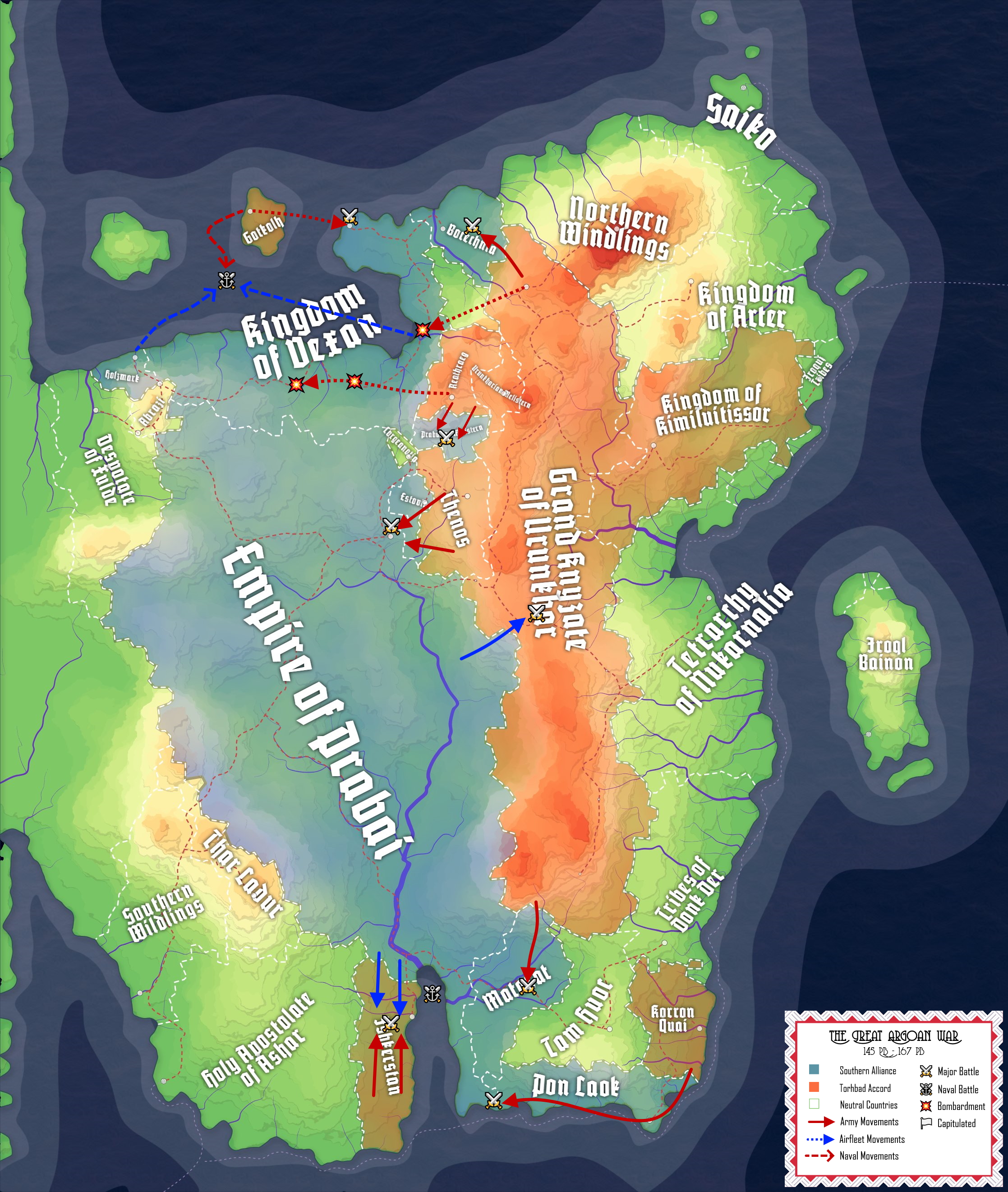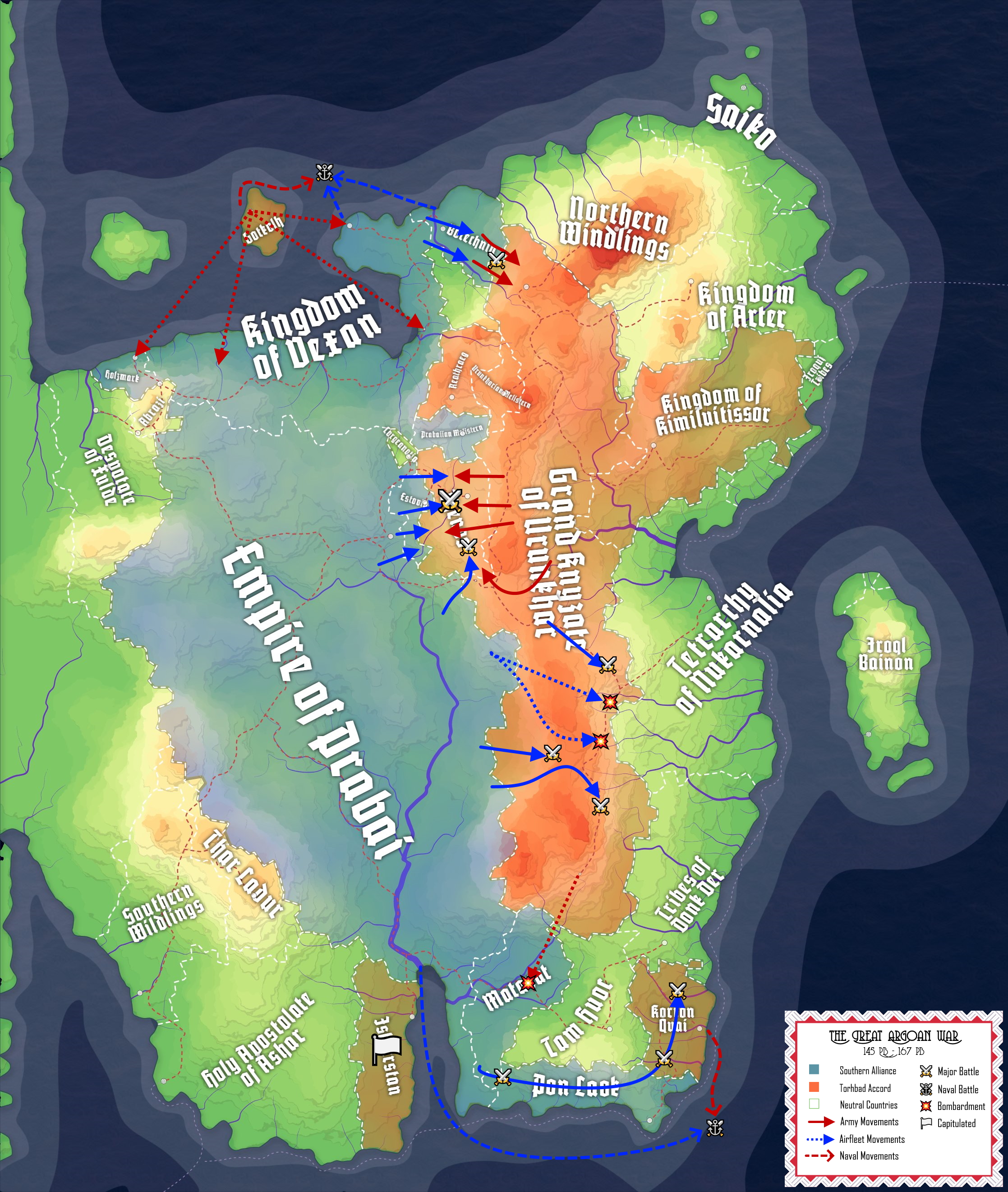The Great Argoan War
Part of the Codex of the Equilibric Age
Prelude
The Vracnar Leak
Up until the 50's PB, it was unthinkable for many that the world, rich in all the resources needed for prosperous life, would soon come under a state of scarcity. The world had technologically and culturally been at a standstill since the latter quarter of the 2nd Age of the Man, as for 300 years, little changed in the ways of living of the peoples of the world. The notable exception, the gnomes of Gotkolh, had largely kept to themselves ever since the great technological and scientific booms of the island kingdom in the early 900's AZ. Having invented various technologies such as more powerful magical engines, effective firearms and efficient non-magical forms of healing, the gnomes for 200 years were held as the nation with the highest standard of living anywhere on West-Argo. This changed when near the end of the 50's PB, 250 years after the discovery of the new technologies, local minerals needed in the manufacture of the new magical engines ran dry, with the stocks running out quick. To sustain the Gothkolian way of living, various expeditions set out to the East Wall to find neutral lands that were rich in the needed minerals, it mostly being Pearlgold. Gotkolh dispatched mining expeditions towards the western part of the Crow's foot mountains, held by various Foul tribes. However, in the process of pacifying the locals, some of the gnomish technology fell into foreign hands near the goblin Kingdom of Vracnar, ending up in the hands of the Thenosian mercenary company Gurutze Gorria, who quickly became one of the richest companies in the then Republic of Thenos, branching out into many different engineering and gunsmithing fields.The Great Arms Race
With the coming of new technologies, namely airtravel and firearms, the race was on. With not a nation like Thenos itself, but a private company being the first on the mainland to get a hold of the new stuff, they set out to profit maximally from their finds, selling patents to numerous nations around the world. But not only would the world adopt the new machines, they would also quickly set out to improve it. With the raging of the 3rd Prabaiian-Ashari war in the south, the Bočechnian revolution in the north of Urunkhar and the Tam Huoc unification wars in the East Bank, the nations of the world set out to one up eachother, leading to more developments over the course of the century, such as the mech-golem, the glider plane, the water cooled machine gun and new non-magical fuel sources, most prominently Resuma fuel.The escalation
In the year 133 PB, the gnomish mines in the western Crows Feet mountains neared their exhaustion, with the king already looking outward for new sources. That same year, Prabai looked eastward towards the culturally prabaiian western lands of Thenos. Simultaneously, a great economic crisis around the turn of the 130's drove many people to growing political radicalism, with various nations making concessions on both internal and external political questions. With rising continental tensions, alliances were formed in case all out war would come. In 140, the Torhbad Accords were signed, initially by Urunkhar and Gotkolh, although Thenos, Kamilliutsor, Ishekerstan and Korron Quan would all join later as well. One year later Prabai, Matarat and Pon Laok signed the Southern Alliance, with Vexan, Bočechnia and Holzmark joining suit before 144. In early 145, war was inevitable. The war officially started in the early morning of the 28th of Quadran 144 PB, when Prabaiian troops crossed the border into Thenos. The Thenosians immediately opened fire, not to stop doing so for an entire generation.Belligerents
The Southern Alliance
Strength
Total Army Strength
68.670.000 infantrymen
10.800.000 cavalrymen
324.700 artillery pieces
54.000 mech tanks
Total Airfleet Strenght
185.000 paratroopers
3270 fighter planes
804 cruiser airships
42 dreadnought airships
2 carrier airships
Total Navy Strenght
152.600 marines
302 gunboats
486 river monitors
152 cruisers
52 dreadnoughts
3 aircraft carriers
Total Army Strenght
67.200.000 infantrymen
900.000 cavalrymen
624.700 artillery pieces
21.100 mech tanks
Total Airfleet Strenght
142.000 paratroopers
5270 fighter planes
1304 cruiser airships
72 dreadnought airships
6 carrier airships
Total Navy Strenght
112.900 marines
132 gunboats
151 river monitors
76 cruisers
35 dreadnoughts
2 aircraft carriers







Comments